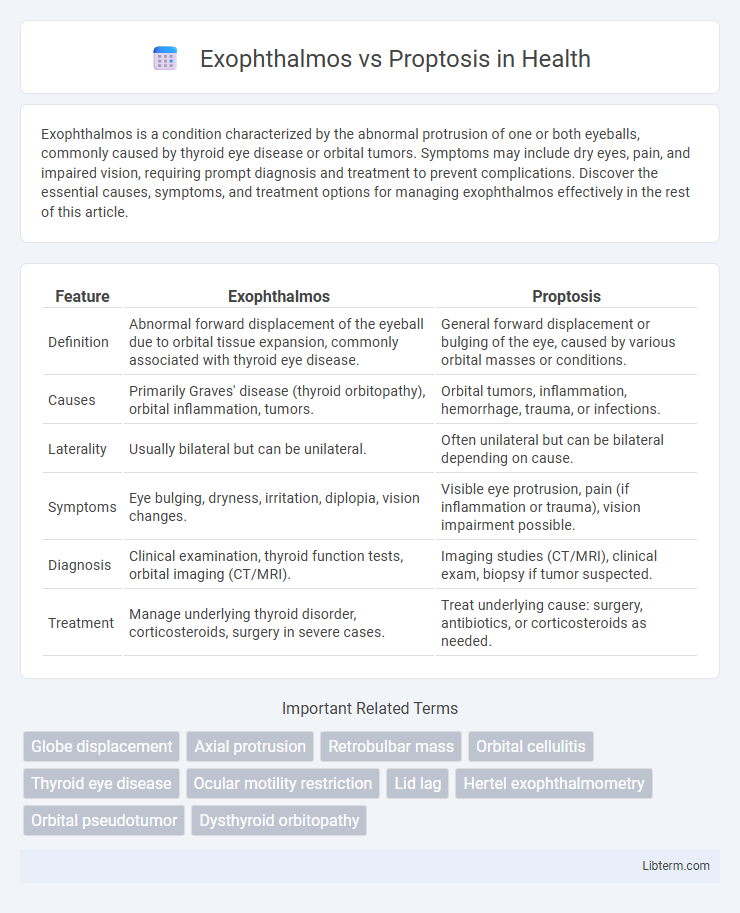Exophthalmos is a condition characterized by the abnormal protrusion of one or both eyeballs, commonly caused by thyroid eye disease or orbital tumors. Symptoms may include dry eyes, pain, and impaired vision, requiring prompt diagnosis and treatment to prevent complications. Discover the essential causes, symptoms, and treatment options for managing exophthalmos effectively in the rest of this article.
Table of Comparison
| Feature | Exophthalmos | Proptosis |
|---|---|---|
| Definition | Abnormal forward displacement of the eyeball due to orbital tissue expansion, commonly associated with thyroid eye disease. | General forward displacement or bulging of the eye, caused by various orbital masses or conditions. |
| Causes | Primarily Graves' disease (thyroid orbitopathy), orbital inflammation, tumors. | Orbital tumors, inflammation, hemorrhage, trauma, or infections. |
| Laterality | Usually bilateral but can be unilateral. | Often unilateral but can be bilateral depending on cause. |
| Symptoms | Eye bulging, dryness, irritation, diplopia, vision changes. | Visible eye protrusion, pain (if inflammation or trauma), vision impairment possible. |
| Diagnosis | Clinical examination, thyroid function tests, orbital imaging (CT/MRI). | Imaging studies (CT/MRI), clinical exam, biopsy if tumor suspected. |
| Treatment | Manage underlying thyroid disorder, corticosteroids, surgery in severe cases. | Treat underlying cause: surgery, antibiotics, or corticosteroids as needed. |
Introduction to Exophthalmos and Proptosis
Exophthalmos and proptosis both refer to the abnormal protrusion of the eyeball, but exophthalmos specifically describes forward displacement associated with conditions like Graves' disease, where autoimmune inflammation causes orbital tissue expansion. Proptosis is a broader term that encompasses any eyeball protrusion due to various causes such as tumors, inflammation, or trauma. Understanding the distinction aids in precise diagnosis and targeted treatment of underlying orbital disorders.
Defining Exophthalmos
Exophthalmos is a medical condition characterized by the abnormal protrusion of the eyeball, often linked to thyroid eye disease such as Graves' orbitopathy. Proptosis, while similar in appearance, is a broader term describing any forward displacement of the eye caused by various factors including tumors, inflammation, or trauma. The key distinction is that exophthalmos specifically refers to thyroid-related eyeball protrusion, whereas proptosis encompasses all etiologies of eye bulging.
Defining Proptosis
Proptosis refers to the abnormal outward displacement or bulging of the eye from the orbit, often caused by orbital tumors, infections, or trauma. Exophthalmos is a specific type of proptosis typically associated with thyroid eye disease, particularly Graves' ophthalmopathy, where inflammation leads to eyeball protrusion. Defining proptosis involves measuring the degree of globe protrusion using tools like a Hertel exophthalmometer to distinguish it from normal anatomical variations.
Key Differences Between Exophthalmos and Proptosis
Exophthalmos refers specifically to the abnormal protrusion of the eyeball due to thyroid eye disease, most commonly Graves' orbitopathy, and is often bilateral with associated inflammation and tissue expansion. Proptosis is a broader term indicating any displacement of the eyeball forward from the orbit, which can result from various causes such as tumors, infections, trauma, or orbital cellulitis, and can be unilateral or bilateral. Key differences include exophthalmos being typically linked to systemic autoimmune conditions, while proptosis encompasses a wider range of underlying pathologies affecting orbital structures.
Common Causes of Exophthalmos
Exophthalmos, frequently caused by Graves' disease, involves the abnormal protrusion of the eyeball due to inflammation and tissue expansion within the orbit. Proptosis is a broader term referring to any forward displacement of the eye, which can result from tumors, trauma, or infections. Understanding that exophthalmos is a specific form of proptosis primarily linked to thyroid eye disease is crucial for accurate diagnosis and treatment.
Common Causes of Proptosis
Proptosis, characterized by the forward displacement of the eye, commonly results from thyroid eye disease, orbital cellulitis, and tumors such as orbital lymphoma or cavernous hemangioma. Inflammatory conditions like orbital pseudotumor and trauma-induced orbital fractures also frequently cause proptosis. Differentiating proptosis from exophthalmos hinges on the underlying etiology, with exophthalmos specifically linked to thyroid orbitopathy.
Clinical Presentation and Symptoms
Exophthalmos is characterized by abnormal protrusion of the eyeball, commonly associated with thyroid eye disease, presenting with symptoms such as eyelid retraction, periorbital edema, and diplopia. Proptosis refers to the anterior displacement of the globe regardless of etiology, often accompanied by eyelid swelling, ocular discomfort, and decreased visual acuity. Clinical differentiation relies on identifying systemic signs like hyperthyroidism in exophthalmos versus localized orbital pathology in proptosis.
Diagnostic Approaches
Exophthalmos and proptosis are often evaluated through clinical examination and imaging techniques such as CT or MRI to assess orbital structures and distinguish underlying causes like thyroid eye disease or tumors. Ultrasonography can provide additional information on extraocular muscle enlargement and orbital fat changes specific to exophthalmos. Laboratory tests including thyroid function panels aid in diagnosing Graves' orbitopathy associated with exophthalmos, while careful differentiation from other etiologies of proptosis guides appropriate management.
Treatment and Management Options
Exophthalmos treatment primarily targets the underlying cause, such as Graves' orbitopathy, with options including corticosteroids, orbital decompression surgery, and immunosuppressive therapy. Proptosis management varies depending on etiology, ranging from observation in mild cases to surgical intervention for tumors, infections, or trauma-induced globe displacement. Both conditions require multidisciplinary approaches involving ophthalmologists, endocrinologists, and sometimes neurosurgeons to optimize functional and cosmetic outcomes.
Prognosis and Complications
Exophthalmos, often linked to thyroid eye disease, typically shows a more chronic progression with potential for optic neuropathy and corneal exposure as major complications, affecting long-term vision prognosis. Proptosis, caused by diverse etiologies such as tumors or inflammation, varies widely in prognosis depending on the underlying condition, with risks including orbital compartment syndrome and vision loss if untreated. Early diagnosis and targeted treatment significantly improve outcomes in both conditions, reducing the likelihood of permanent ocular damage.
Exophthalmos Infographic

 libterm.com
libterm.com